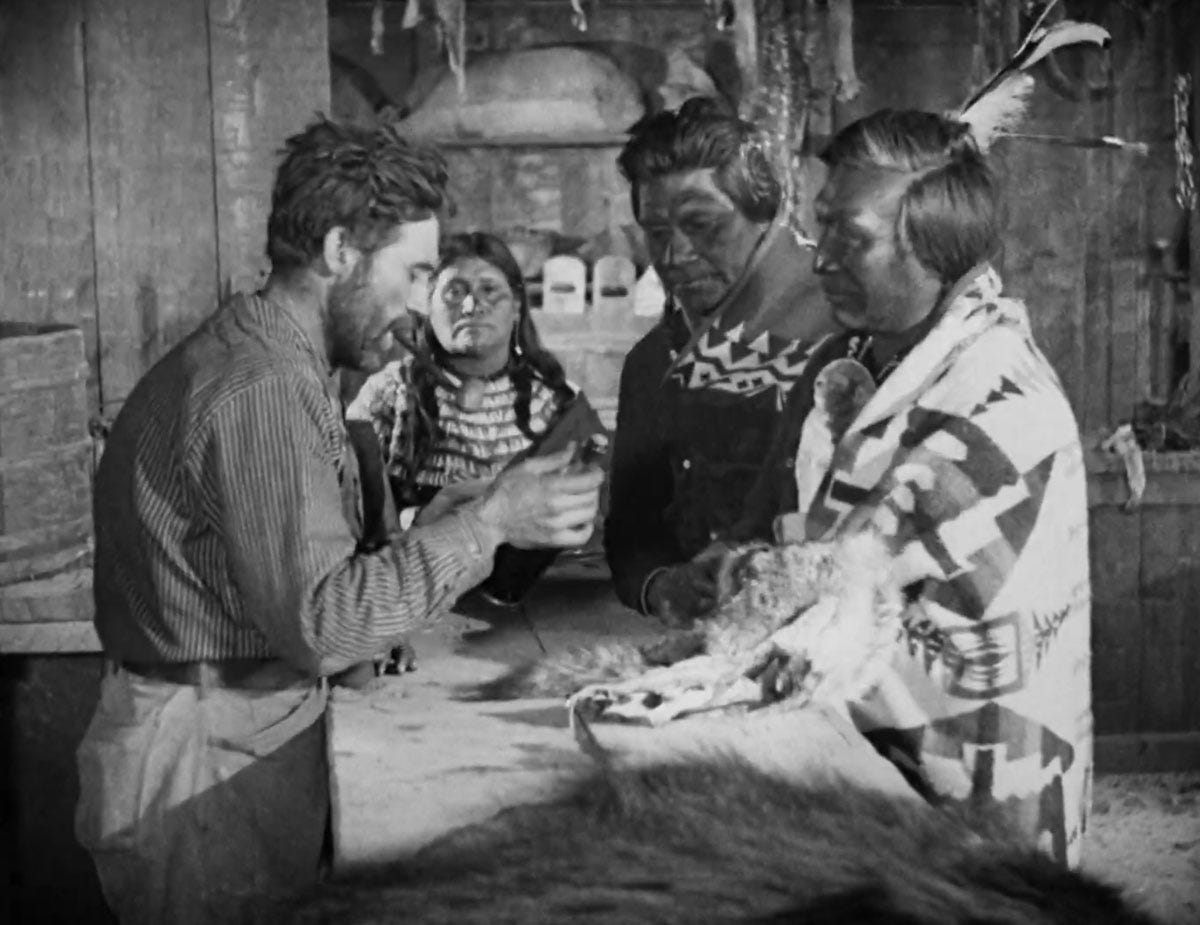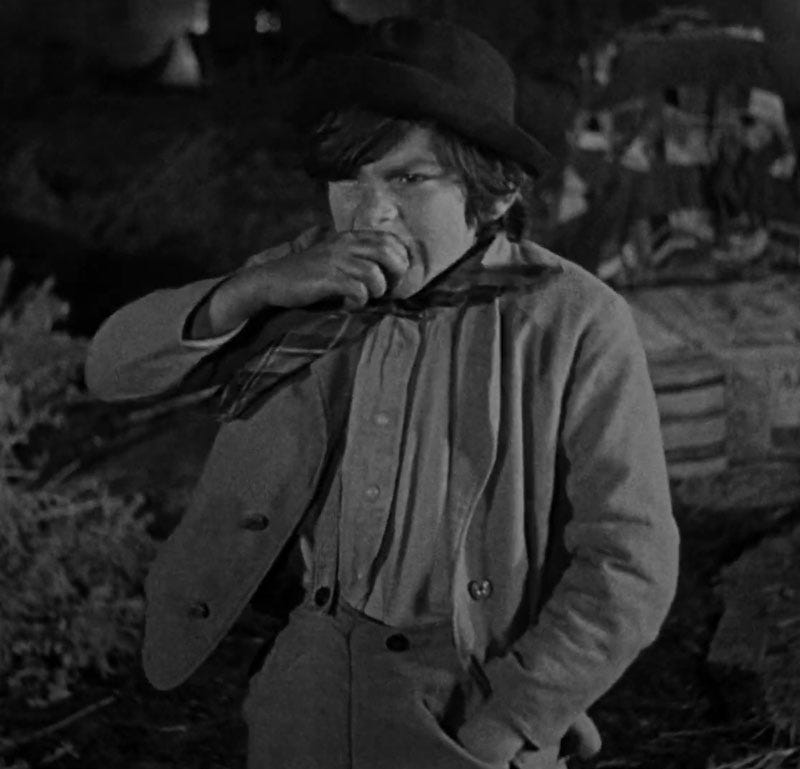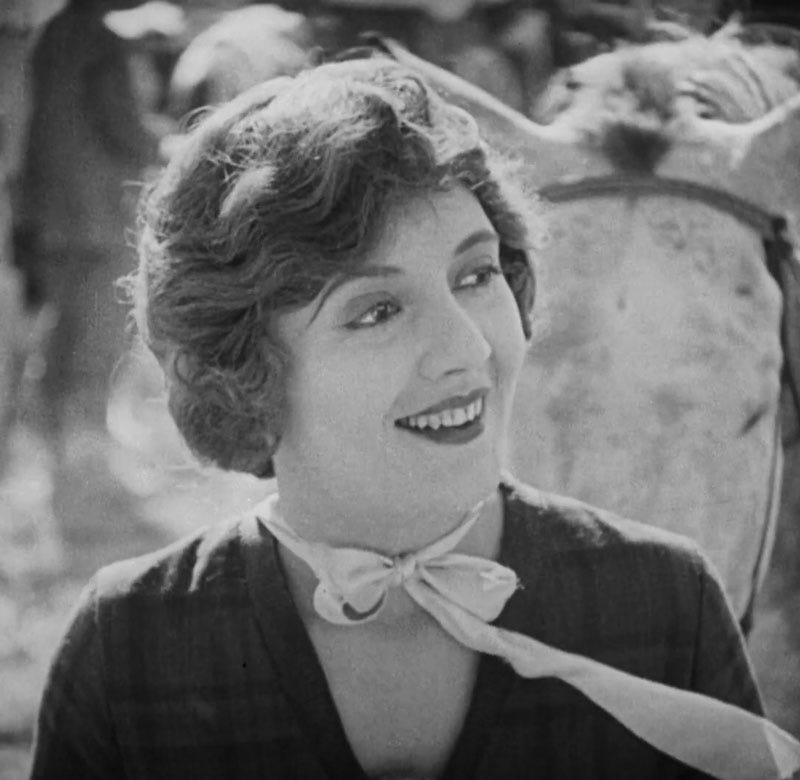GROSS/11 1923 - frontier capitalism WTF
The Covered Wagon is not a great film but it's a genuine secular epic.
Gross is every year’s top-grossing movie, since 1913, reviewed.
THE COVERED WAGON, JAMES CRUZE, FAMOUS PLAYERS-LASKY CORPORATION, 1923, 98 MINUTES. U.S./CANADA GROSS: $4,000,000.
What was the class composition of the Western wagon-trains? What was the economic status of the people in the covered wagons, on the horses beside them and following behind? They were farmers and petty bourgeois - grafters and traders and entrepreneurs sinking their savings into the adventure. The working class was left behind in the growing cities of the East, subsisting in the emerging industrial economy. Meanwhile, the essentially feudal structure of the slave economy dissolved here, replaced by the explosive, out-of-control capitalism of the frontier.
This is the kind of thing I find myself wondering when I’m watching a movie these days. I don’t know what’s wrong with me.
The first epic Western
In this unarguably vast film, called by one writer ‘"the first American epic not directed by [D.W.] Griffith." a cast of thousands (well, hundreds anyway), recreates for us the high-pressure social experiment of the western migration. The cast includes many ordinary people, descendents of the settlers, paid to essentially re-enact the migration (if they brought their own restored covered wagons and horses they were paid $2 per day).
It’s 1923. All the elements of the Western are in place. I can barely bring myself to outline the plot for you (have you seen a Western? You already know it). The landscapes - the endless plains, buttes, canyons, wind-blown forts and wide, slow rivers - are all here too, shot at huge expense and with great compositional style (and decades before Cinemascope) - in California, Utah and Nevada by Karl Brown, an experienced DP who’d worked with Griffith himself.
The gang’s all here
Likewise the whole repertory company of Western types is here - the grizzled old-timer, the laconic hero with a secret, the feisty young woman impatient for freedom, the frightened family man, the cowardly villain, the lone scout in his coonskin hat. Critically, the movie-makers of this era didn’t need to invent these types or even the performance modes they needed - they all already existed, written out in detail in the cowboy novels and serials and rehearsed by performers for decades in the touring Wild West shows, which were essentially the immediate predecessor of the movies in the public’s early 20th Century entertainment diet.
In the movie’s social mix, native Americans are present. And the tribal people represented - while never allowed to acquire personalities or to own much of the story - are not ciphers. They’re traders and business-people (a group of ‘friendly indians’ operates a horse-drawn river ferry for the wagon trains). They live among the whites (Jim Bridger, the scout, has two native wives) and their motivations are not reduced to bestiality and cruelty as they were in later Westerns.
The indians participate in the frontier model of justice, killing when attacked by the settlers, cooperating when left alone. Otherwise they’re present in the background - drinking, trading. I’ve watched a few early Westerns now (a huge number were made in the silent era) and I’ve convinced myself the way that they depict native Americans is different from the movies of the so-called ‘golden age’ - the 40s and 50s. The later films seem often to have reverted to a simpler, more brutal representation of native Americans. Can I speculate this is connected with the peak of Jim Crow racism and segregation that came before the civil rights era (and also with the generalised hostility and paranoia of the cold-war?). It wasn’t until the ‘revisionist’ Westerns of the 1960s that native Americans took on more complex roles again.
Performances, wooden and otherwise
The early cinema brought together a wild variety of talent - the pipeline into the movie acting profession was not a tidy one. As is often the case, all the most interesting performances in The Covered Wagon are from the secondary cast. Our hero and his anti-hero counterpart are both on the timber spectrum - blocks of wood without the charm they were born with. When they fight in the dust we want them both to lose. In the supporting cast, embittered wagon-train veteran William Jackson is played, remarkably, by operatically-trained Edinburgh-born Ernest Torrence, a 6’4” giant who gurns and chews tobacco pretty convincingly for a graduate of the Stuttgart Conservatory. Even-more-grizzled trail scout Jim Bridger is played by Tully Marshall, a fascinating man whose sixty-year career took in 25 years in the serious theatre, the whole silent era and 50 talkies. He was a director and producer too and was married to another cinema innovator, Marion Fairfax, from 1899 until his death in 1943.
Another critically important character is Jed Wingate, played by Johnny Fox, the heroine’s young brother, a boy of about ten who swaggers around the camp, offering the grown-ups hunks of his chaw and playing his banjo winningly. At the critical moment, as his family’s wagon-train is about to be over-run by marauding indians, he escapes to summon Will Banion (Block of Wood number two) who shows up in the nick of time with a posse of settlers to see off the attackers. Oddly we barely see him again and he’s never acknowledged for his vital rescue mission. Fox made dozens of films but nothing after 1929, although he lived a long life - he doesn’t seem to have escaped either the silents or the role of a child actor. We can only hope his mum and dad put his movie earnings into a trust fund.
The winner here, though, is Lois Wilson, playing heroine Molly Wingate, daughter of the wagon-train captain, betrothed to one of the blocks of wood but in love with the other one. She’s barely on screen, she simpers and apologises constantly and, in one of those deeply annoying scenes often added to any film requiring some visible masculinity, has to be rescued by one of the blocks of wood when her horse bolts - but she’s really the film’s centre. All the storylines pass through her, her decisions are big and consequential - she dumps Block of Wood number one in a heartbeat while already dressed for the wedding. In the story she’s grown from giggling city girl into a gutsy frontierswoman and her choices essentially shape the lives of the settlers once they reach journey’s end in Oregon. Lois Wilson had been a schoolteacher and had entered the movies via a studio beauty contest: a second-ranking star who became a close friend of Gloria Swanson. She didn’t prosper in the talkies but became a TV soap fixture in the 1950s.
It’s the manifest destiny, stupid
As you’d expect, the whole adventure is held together by the economics. There’s no Western frontier without the draw of the profits at the end of the trail, without the promise of unexploited land and unextracted resources. Manifest destiny, a phrase coined by a journalist to sacralise the migration of the European settlers and the expulsion of the indigenous people, is the thinnest of all possible premises for the settler project - a rhetorical device, a fiction. Settler colonialism, defined by historians and economists, is not the same as the colonialism of the old empires but what it has in common with the older form is that it is always and everywhere an economic phenomenon.
The farmers and traders in our wagon-train are heading for Oregon. Some are diverted to California by the promise of gold. It’s the 1840s. Trails are being opened, new tracts of land set aside for farming, territories are becoming states. All of this extraordinary entrepreneurial energy, all of the invention and creation that goes into shaping the new settler communities is driven by acquisition, by the interests of investors and producers. And what’s created is unarguably remarkable.
In Oregon, only a few years after this wave of colonists from the East had arrived, a university was under construction, factories were replacing goods expensively brought across the country, harbours and roads had been built. Modern cast-iron buildings were going up in Portland from the 1850s. And all of this came at the expense of the natives. Expulsions, even from land that had already been set aside for indian tribes, were routine. Productive land and sites suited to construction were stolen first, indians moved to less valuable areas.
There’s no concealing or diminishing the brutality of the process and what’s fascinating about The Covered Wagon is the degree to which it makes visible the violence and hardship. There’s a complete absence of manifest destiny hokum. Our settlers are out to improve their lives, not to fulfil the promise of a new nation or to glorify the republic. They may be religious folk but they’re not doing God’s work. This wagon-train is a capitalist tool.
I watched the film on YouTube. It’s a lovely print with a perfectly bearable musical accompaniment. There’s a Blu-Ray.
In this film, as in others of the period, only the main roles are listed in the credits, so it’s not particularly surprising that the names of the native American actors are not recorded. Only the contribution of Chief Thunderbird, a Hollywood veteran by the time of this release, is recorded anywhere.
James Cruze, the film’s director, was a mormon. There’s nothing particularly mormon about the film but there’s an odd aside, in which wagon-train captain Jesse Wingate stops to pick up a buffalo skull at the side of the trail and we see it was left by Brigham Young, founder of mormonism, on his own passage along the trail - “…if he could get his wives across, I can get my wagons.” Cruze made or acted in over 100 films but his career didn’t survive the arrival of sound. He couldn’t get work and committed suicide in 1942.
There’s an authentically grim buffalo hunting scene. Vegetarians look away now. According to Wikipedia, seven buffalo (bison) from the Antelope Island Bison Herd were killed in the shooting of the scene but there’s some disagreement about the scale of the hunt: IMDB claims that cinematographer Karl Brown made use of dozens of model bison in various sizes, moved on rails, to achieve the effect of the herd.
When we meet Block of Wood number two - former soldier Will Banion, played by J. Warren Kerrigan - we’re told he’s been dishonourably discharged for cattle theft but later in the movie news arrives that a lawyer back East has had him exonerated. The lawyer, we learn, is one Abe Lincoln, who was at the time at the bar in Washington DC.
J. Warren Kerrigan had his own military problems. When asked why he wasn’t serving during the first world war. He’d explained: “I am not going to war. I will go, of course, if my country needs me, but I think that first they should take the great mass of men who aren't good for anything else, or are only good for the lower grades of work…” His career never fully recovered.
In his autobiography Akira Kurosawa provides a list of films that were important to him in the years he first saw them. The Covered Wagon is included, alongside Chaplin’s The Pilgrim and Abel Gance’s La Roue. A Redditter helpfully typed the whole list up.








